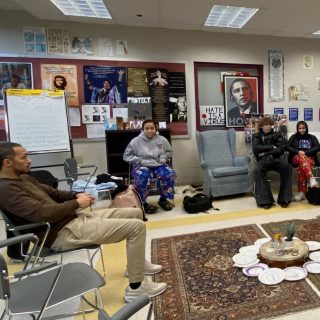Early decision college season in full swing

Each October, a good number of ARHS seniors are under water, with early decision or early action college deadlines approaching ever so quickly. They try to figure out how to use three different apps (Common App, Scoir, and College Board) that all serve different functions in enabling their applications, while their parents wrestle with the FAFSA and the CSS Profile, if they are applying for financial aid. There is what feels like an insurmountable pressure to write a top-tier essay and multiple supplemental essays for each school that they are applying to.
On top of that, they are seeing and hearing about all the other students who are telling them what they’ve done to get ahead. Their parents and guardians are pushing them to get it all done, and are likely bringing up how hard it will be to pay for it all once they’re in.
These students are also still trying to balance all of the work surrounding college with their athletics, clubs, work, and school, which everyone has been telling them are of great importance over the last four years. It is a hard time for seniors, who say they often feel like there is so much to do in so little time.
Researching schools, putting the best ones in both the Common App and Scoir, making meetings with teachers and counselors who are writing recommendations, answering scores of questions, submitting college board tests, and paying the money for all of these applications, can be overwhelming.
But just take a step back and breathe. One step at a time.
Acceptance and Early Decision.
For the class of 2023, Amherst sent 81% of its students to higher education institutions with a 7:1 ratio of four-year colleges to two-year colleges. This class sent many of its students to UMass Amherst, a top-tier public research university in our backyard, and also to private colleges and universities such as Yale, Brown, Dartmouth, and MIT. This year, students in the class of 2024 have passed, or are nearing, many of their early deadlines.
Senior Miguel Pinero Jacome decided to apply Early Decision to Carnegie Mellon. This means that, if he is accepted, he will attend this institution.
“I was enthralled by the academic spirits and innovative passions of the students and atmosphere at Carnegie Mellon,” he said. He also plans to apply early action to Northeastern due to their lack of required essays.
Early decision applications are on the rise in Amherst, because of the heightened acceptance rate for applicants applying for early decision.
There is also a financial component in that there is no way to compare financial aid packages offered by different schools.
Deidre Cuffee-Gray, College and Career Advisor, understands the complicated nature of early decision and the college process as a whole.
“There are a lot of moving parts for students,” she said. “There’s [much more in the mix] than just what they’ve done academically and how that dictates what schools they are reasonably acceptable to.”
Application Process
Many parents or family friends help students out by taking them to look at colleges and helping to pay the fees for tests and applications, while others offer essay support.
The visiting process is a good way to see if a student likes the way it feels to be on campus.
Senior, Juliet Coleman has been visiting schools on most weekends of this school year, and she has narrowed down her list to nine schools.
“Some of them I visited, and I liked them, but the other ones my mother told me I should apply to,” Coleman said.
Parents can also help navigate the financial forms and help students determine their path toward post-secondary education.
When applying, it can feel very difficult to deal with both the Common App and Scoir.
These two are used for different functions. “The common app is [where you upload] your essay, your supplemental questions, [and] what you say about your education,” Cuffee-Gray said, and Scoir is the platform the school uses to send your information; it’s also where teachers upload recommendations.
Cuffee-Gray said it helps when students stay updated on the process via her emails and check-ins. There is also a college application checklist that outlines each step that a student needs to take to submit everything; it’s attached to the Life After ARHS Google Classroom.
Peer Pressure
Every senior is in a different spot in the application process. But college is a huge conversation among seniors. It can be very stressful for students who are just starting their process to hear about everything that their peers have already finished. “Everyone seems so ready to go,” Coleman said.
The summer is when students are expected to complete their essays and parts of their application, but many don’t. “That’s always the suggestion, ‘do it in the summer,'” Cuffee-Gray said, “but is that realistic to ask a student?”
She said many teens spend their summers working, on vacations, or out of town and college may be the last thing anyone wants to think about. After they come back, the deadlines are looming.
“I go into a room of juniors and they’re like, ‘Are you talking to me?’ And then I go into a room with seniors [saying] ‘I need you to talk to me,” Cuffee-Gray said.
Early applications are becoming more and more popular, with 40 Amherst seniors applying early decision when I spoke to Cuffee-Gray. Coleman said she was applying Early Action not Early Decision, which will give her early notification about her standing but she won’t be bound to those schools.
Accepted
With all of these components, it’s easy for students to feel overwhelmed by the circus-grade balancing act.
But by the end of April, every one of these stressed-out Amherst students will have an acceptance letter.
With nearly 4,000 colleges in America and many more abroad, Cuffee Gray said they needn’t worry too much. “There’s more than one college to fall in love with,” she said.














